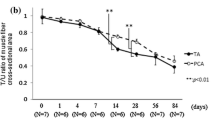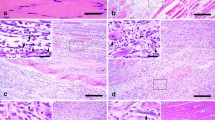Abstract
The objective of this study was to investigate the myofiber subtype transition of human posterior cricoarytenoid (PCA) muscle after the injury to recurrent laryngeal nerve (RLN). PCA muscle specimens were obtained from 38 bilateral vocal fold paralysis patients underwent arytenoidectomy. According to the duration of RLN injury, all the cases were divided into five denervation groups: 6–12 months, 1–2, 2–3, 3–6, and >6 years. The normal PCA muscles from total laryngectomy patients were chosen as controls. Immunofluorescence was adopted to detect the expression level of myosin heavy chain (MHC)-I and MHC-II in PCA muscle. Quantitative real-time PCR was also used to assess the transcriptional level of MHC subtypes (MHC-I, MHC-IIa, MHC-IIb, MHC-IIx, embryonic-MHC, and peri-natal-MHC). Immunofluorescence showed that MHC-I-positive myofibers in denervation groups were much lower than control group, respectively, while MHC-II-positive myofibers were significantly higher than control group (P < 0.05). With the extension of denervation, the number of MHC-I-positive myofibers gradually decreased, while MHC-II gradually increased and peaked in 1- to 2-year group. Transcriptional level of MHC-I, MHC-IIa, and MHC-IIb in denervation groups significantly down-regulated compared with the control (P < 0.05), respectively. However, MHC-IIx, embryonic-MHC, and peri-natal-MHC significantly up-regulated in all denervation groups, and the highest level was in 1- to 2-year denervation group. Data from the present study demonstrated that the maximum transition of MHC subtypes in human PCA muscles occurred in 1–2 years after denervation, suggesting that laryngeal reinnervation before the occurrence of irreversible transition of MHC subtypes could maintain the structural integrity of laryngeal PCA muscles.




Similar content being viewed by others
References
Shiotani A, Flint PW (1998) Myosin heavy chain composition in rat laryngeal muscles after denervation. Laryngoscope 108:1225–1229
Shiotani A, Westra WH, Flint PW (1999) Myosin heavy chain composition in human laryngeal muscles. Laryngoscope 109:1521–1524
Wu YZ, Crumley RL, Baker MJ, Armstrong WB, Caiozzo VJ (2000) New perspectives about human laryngeal muscle: single fiber analysis and interspecises comparisons. Arch Otolayngol, Head Neck Surg 126:857–864
Buller AJ, Eccles JC, Eccles RM (1960) Interactions between motoneurons and muscles in respect of the characteristics speed of their responses. J Physiol (Lond) 150:417–439
Wu YZ, Baker MJ, Marie JP et al (2004) The plasticity of denervated and reinnervated laryngeal muscle: focus on single-fiber myosin heavy-chain isoform expression. Arch Otolaryngol Head Neck Surg 130:1070–1082
Shiotani A, Nakagawa H, Flint PW (2001) Modulation of myosin heavy chains in rat laryngeal muscle. Laryngoscope 111:472–477
Adreani CM, Li ZB, Lehar M, Southwood LL et al (2006) Myosin heavy chain composition in normal and atrophic equine laryngeal muscle. Vet Pathol 43:881–889
Huey KA, Bodine SC (1998) Changes in myosin mRNA and protein expression in denervated rat soleus and tibialis anterior. Eur J Biochem 256:45–50
Li M, Chen S, Wang W, Chen D et al (2014) Effect of duration of denervation on outcomes of ansa-recurrent laryngeal nerve reinnervation. Laryngoscope 124:1900–1905
Li M, Chen S, Zheng H, Chen D et al (2013) Reinnervation of bilateral posterior cricoarytenoid muscles using the left phrenic nerve in patients with bilateral vocal fold paralysis. PLoS One 8(10):e77233
Donghui C, Shicai C, Wei W et al (2010) Functional modulation of satellite cells in long-term denervated human laryngeal muscle. Laryngoscope 120:353–358
Liu W, Saint DA (2002) Validation of a quantitative method for real time PCR kinetics. Biochem Biophys Res Commun 294:347–353
Bottinelli R (2001) Functional heterogeneity of mammalian single muscle fibres: do myosin isoforms tell the whole story? Pflugers Arch 443:6–17
Li ZB, Lehar M, Nakagawa H et al (2004) Differential expression of myosin heavy chain isoforms between abductor and adductor muscles in the human larynx. Otolaryngol Head Neck Surg 130:217–222
Perie S, Agbulut O, St GJL et al (2000) Myosin heavy chain expression in human laryngeal muscle fibers: a biochemical study. Ann Otol Rhinol Laryngol 109:216–220
Bacou F, Rouanet P, Barjot C et al (1996) Expression of myosin isoforms in denervated, cross-reinnervated, and electrically stimulated rabbit muscles. Eur J Biochem 236:539–547
Patterson MF, Stephenson GM, Stephenson DG (2006) Denervation produces different single fiber phenotypes in fast- and slow-twitch hindlimb muscles of the rat. Am J Physiol Cell Physiol 291:C518–C528
Jakubiec-Puka A, Ciechomska I, Morga J et al (1999) Contents of myosin heavy chains in denervated slow and fast rat leg muscles. Comp Biochem Physiol B Biochem Mol Biol 122:355–362
Wu YZ, Baker MJ, Crumley RL et al (2000) Single-fiber myosin heavy chain isoform composition of rodent laryngeal muscle modulation by thyroid hormone. Arch Otolaryngol Head Neck Surg 126:874–880
Smerdu V, Cvetko E (2013) Myosin heavy chain-2b transcripts and isoform are expressed in human laryngeal muscles. Cells Tissues Organs 198:75–86
Jung HH, Han SH, Choi JO (1999) Expression of myosin heavy chain mRNA in rat laryngeal muscles. Acta Otolaryngol 119:396–402
Toniolo L, Maccatrozzo L, Patruno M et al (2005) Expression of eight distinct MHC isoforms in bovine striated muscles: evidence for MHC-2B presence only in extraocular muscles. J Exp Biol 208:4243–4253
Malmgren LT, Lovice DB, Kaufman MR (2000) Age-related changes in muscle fiber regeneration in the human thyroarytenoid muscle. Arch Otolaryngol Head Neck Surg 126:851–856
Schiaffino S, Gorza L, Saggin L et al (1988) Embryonic and neonatal myosin heavy chain in denervated and paralyzed rat skeletal muscle. Dev Biol 127:1–11
Donghui C, Shicai C, Wei W et al (2010) Functional modulation of satellite cells in long-term denervated human laryngeal muscle. Laryngoscope 120:353–358
Chen D, Chen S, Wang W et al (2011) Spontaneous regeneration of recurrent laryngeal nerve following long-term vocal fold paralysis in humans: histological evidence. Laryngoscope 121:1035–1039
Nomoto M, Yoshihara T, Kanda T et al (1991) Synapse formation by autonomic nerves in the previously denervated neuromuscular junctions of the feline intrinsic laryngeal muscles. Brain Res 539:276–286
Acknowledgments
This work was supported by Grant No. 81070774, 81371081, and 81400455 for science research from National Natural Science Foundation of China, and Grant No. 2010235 from Shanghai Municipal Commission of Health and Family Planning.
Author information
Authors and Affiliations
Corresponding authors
Additional information
X. Qiu, D. Chen and M. Li contributed equally to this research.
Rights and permissions
About this article
Cite this article
Qiu, X., Chen, D., Li, M. et al. Transition of myosin heavy chain isoforms in human laryngeal abductors following denervation. Eur Arch Otorhinolaryngol 272, 2915–2923 (2015). https://doi.org/10.1007/s00405-015-3664-z
Received:
Accepted:
Published:
Issue Date:
DOI: https://doi.org/10.1007/s00405-015-3664-z




